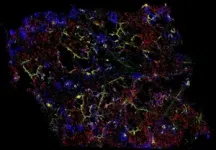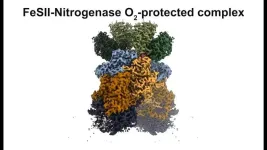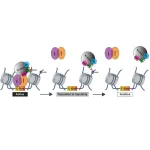(Press-News.org) LA JOLLA (January 8, 2025)—Human bodies defend themselves using a diverse population of immune cells that circulate from one organ to another, responding to everything from cuts to colds to cancer. But plants don’t have this luxury. Because plant cells are immobile, each individual cell is forced to manage its own immunity in addition to its many other responsibilities, like turning sunlight into energy or using that energy to grow. How these multitasking cells accomplish it all—detecting threats, communicating those threats, and responding effectively—has remained unclear.
New research from Salk Institute scientists reveals how plant cells switch roles to protect themselves against pathogens. When a threat is encountered, the cells enter a specialized immune state and temporarily become PRimary IMmunE Responder (PRIMER) cells—a new cell population that acts as a hub to initiate the immune response. The researchers also discovered that PRIMER cells are surrounded by another population of cells they call bystander cells, which seem to be important for transmitting the immune response throughout the plant.
The findings, published in Nature on January 8, 2025, bring researchers closer to understanding the plant immune system—an increasingly important task amid the growing threats of antimicrobial resistance and climate change, which both escalate the spread of infectious disease.
“In nature, plants are constantly being attacked and require a well-functioning immune system,” says Professor Joseph Ecker, senior author of the study, Salk International Council Chair in Genetics, and Howard Hughes Medical Institute investigator. “But plants don’t have mobile, specialized immune cells like we do—they must come up with an entirely different system where every cell can respond to immune attacks without sacrificing their other duties. Until now, we weren’t quite sure how plants were accomplishing this.”
Plants encounter a wide range of pathogens, like bacteria that sneak in through leaf surface pores or fungi that directly invade plant “skin” cells. Since plant cells are stationary, when they encounter any of these pathogens, they become singularly responsible for responding and alerting nearby cells. Another interesting side effect of immobile cells is the fact that different pathogens may enter a plant at different locations and times, leading to varying immune response stages occurring simultaneously across the plant.
With factors like timing, location, response state, and more all at play, an infected plant is a complicated organism to understand. To tackle this, the Salk team turned to two sophisticated cell profiling techniques called time-resolved single-cell multiomics and spatial transcriptomics. By pairing the two, the team was able to capture the plant immune response in each cell with unprecedented spatiotemporal resolution.
"Discovering these rare PRIMER cells and their surrounding bystander cells is a huge insight into how plant cells communicate to survive the many external threats they face day-to-day,” says first author Tatsuya Nobori, a former postdoctoral researcher in Ecker’s lab and current group leader at The Sainsbury Laboratory in the United Kingdom.
The team introduced bacterial pathogens to the leaves of Arabidopsis thaliana—a flowering weed in the mustard family commonly used as a model in research. They then analyzed the plant’s response to comprehensively identify each cell’s state upon infection. In doing so, they discovered a novel immune response state, which they called PRIMER, that emerged in cells at specific immune hotspots. The PRIMER cells expressed a new transcription factor—a type of protein that regulates gene expression—called GT-3a, which is likely an important upstream alarm for alerting other cells to an active plant immune response.
Additionally, the cells surrounding these PRIMER cells proved equally important. Dubbed “bystander cells,” the cells immediately neighboring PRIMER cells were expressing genes that enable long-distance cell-to-cell communication. The researchers plan to elucidate this relationship in future research, but for the time being, they suspect the interactions between PRIMER and bystander cells are key to propagating the immune response across the leaf.
This new spatiotemporal, cell-specific insight into the plant immune response is already available as a reference database for researchers worldwide. As pathogens continue to evolve and spread amid climate-related environmental changes and rising antibiotic resistance, the database offers an important springboard for preserving a future filled with healthy plants and crops.
“There is a lot of interest and demand for detailed cell atlases these days, so we’re excited to create a new one that is publicly available for other researchers to use,” says Ecker. “Our atlas could lead to many new discoveries about how individual plant cells respond to environmental stressors, which will be crucial for creating more climate-resilient crops.”
Other authors include Joseph Nery of Salk; Alexander Monell of Salk and UC San Diego; Travis Lee of Salk and Howard Hughes Medical Institute; Yuka Sakata, Shoma Shirahama, and Akira Mine of University of Kyoto in Japan.
The work was supported by the Howard Hughes Medical Institute and Human Frontiers Science Program.
About the Salk Institute for Biological Studies:
Unlocking the secrets of life itself is the driving force behind the Salk Institute. Our team of world-class, award-winning scientists pushes the boundaries of knowledge in areas such as neuroscience, cancer research, aging, immunobiology, plant biology, computational biology, and more. Founded by Jonas Salk, developer of the first safe and effective polio vaccine, the Institute is an independent, nonprofit research organization and architectural landmark: small by choice, intimate by nature, and fearless in the face of any challenge. Learn more at www.salk.edu
END
Plant cells gain immune capabilities when it’s time to fight disease
Salk scientists discovered that plant cells enter a rare immune state to fight pathogens and sound threat alarms throughout the plant
2025-01-08
ELSE PRESS RELEASES FROM THIS DATE:
Study sheds light on depression in community-dwelling older adults
2025-01-08
January 8, 2025—Marked variation in the prevalence of depression was found in a multisite sample of community-dwelling older adults in the United States reports a study by Columbia University Mailman School of Public Health. Until now, few studies, have examined the frequency of depression in community-dwelling older adults in the U.S. The study is published in the Journal of American Geriatrics Society.
Of the 2,900 participants studied, 6.2 percent had depression. Older adults who had a negative history of depression or had annual household incomes of $50,000 or greater were at significantly decreased ...
Discovery of new class of particles could take quantum mechanics one step further
2025-01-08
PROVIDENCE, R.I. [Brown University] — Amid the many mysteries of quantum physics, subatomic particles don’t always follow the rules of the physical world. They can exist in two places at once, pass through solid barriers and even communicate across vast distances instantaneously. These behaviors may seem impossible, but in the quantum realm, scientists are exploring an array properties once thought impossible.
In a new study, physicists at Brown University have now observed a novel class of quantum particles called fractional excitons, which behave in unexpected ways and could significantly ...
Cost-effectiveness of a polypill for cardiovascular disease prevention in an underserved population
2025-01-08
About The Study: The results of this economic evaluation suggest that cardiovascular polypill treatment (single pill containing a statin and 3 half-standard dose antihypertensives) could be a high value intervention for a low-income, majority Black population with limited access to health care services. It could additionally reduce health disparities.
Corresponding Author: To contact the corresponding author, Ciaran N. Kohli-Lynch, PhD, email ciaran.kohli-lynch@northwestern.edu.
To access the embargoed study: Visit our For The Media ...
Development and validation of a tool to predict onset of mild cognitive impairment and Alzheimer dementia
2025-01-08
About The Study: In this prognostic study, with the use of a statistical modeling approach, the Florey Dementia Index was developed and validated to predict the onset age of mild cognitive impairment and Alzheimer dementia. This tool may be useful in organizing health care for older adults with cognitive decline or dementia and in the future may help prioritize patients for the use of disease-modifying monoclonal antibody drugs.
Corresponding Authors: To contact the corresponding authors, email Yijun Pan, PhD (yijun.pan@unimelb.edu.au) ...
New AI predicts inner workings of cells
2025-01-08
NEW YORK, NY (Jan. 8, 2025)--Using a new artificial intelligence method, researchers at Columbia University Vagelos College of Physicians and Surgeons can accurately predict the activity of genes within any human cell, essentially revealing the cell’s inner mechanisms. The system, described in the current issue of Nature, could transform the way scientists work to understand everything from cancer to genetic diseases.
“Predictive generalizable computational models allow to uncover biological ...
Scientists uncover key step in how diazotrophs “fix” nitrogen
2025-01-08
Nitrogen is an essential component in the production of amino acids and nucleic acids — both necessary for cell growth and function. Although the atmosphere is composed of nearly 80% nitrogen, this nitrogen is in the form of dinitrogen (N2), which cannot be processed by most organisms. Atmospheric nitrogen must first be converted, or “fixed,” into a form that can be used by plants, often as ammonia.
There are only two ways of fixing nitrogen, one industrial and one biological. To better understand a key component of the biological process, University of California San Diego Professor of Chemistry and Biochemistry Akif Tezcan and Assistant Professor of Chemistry ...
The hidden mechanics of earthquake ignition
2025-01-08
A new study has unravelled the hidden mechanics of how earthquakes ignite, shedding light on the mysterious transition from quiet, creeping motion to the violent ruptures that shake the Earth. Using cutting-edge experiments and innovative models, the research reveals that slow, silent stress release is a prelude and a necessary trigger for seismic activity. By incorporating the overlooked role of fault geometry, the study challenges long-held beliefs and offers a fresh perspective on how and when earthquakes begin. These findings not only deepen our understanding of nature’s ...
Scientists leverage artificial intelligence to fast-track methane mitigation strategies in animal agriculture
2025-01-08
BUSHLAND, Texas, Jan. 8, 2025 –A new study from USDA’s Agricultural Research Service (ARS) and Iowa State University (ISU) reveals that generative Artificial Intelligence (AI) can help expedite the search for solutions to reduce enteric methane emissions caused by cows in animal agriculture, which accounts for about 33 percent of U.S. agriculture and 3 percent of total U.S. greenhouse gas emissions.
"Developing solutions to address methane emissions from animal agriculture is a critical priority. Our scientists continue to use innovative and data-driven strategies to help ...
Researchers unravel a novel mechanism regulating gene expression in the brain that could guide solutions to circadian and other disorders
2025-01-08
A collaborative effort between Mount Sinai and Memorial Sloan Kettering Cancer Center has shed valuable light on how monoamine neurotransmitters such as serotonin, dopamine, and now histamine help regulate brain physiology and behavior through chemical bonding of these monoamines to histone proteins, the core DNA-packaging proteins of our cells.
By uncovering how these histone modifications influence the brain, the team has identified a novel mechanism for controlling circadian gene expression and behavioral rhythms. ...
Discovery of 'Punk' and 'Emo' fossils challenges our understanding of ancient molluscs
2025-01-08
Researchers have unearthed two fossils, named Punk and Emo, revealing that ancient molluscs were more complex and adaptable than previously known.
Molluscs are one of life’s most diverse animal groups and analysis of the rare 430 million year old fossils is challenging long-held views on their early origins.
The fossils dating from the Silurian period were retrieved from Herefordshire and shed light on the molluscs’ complex evolutionary history and how they moved.
The discovery challenges the longstanding ...
LAST 30 PRESS RELEASES:
First ‘Bible map’ published 500 years ago still influences how we think about borders
Why metabolism matters in Fanconi anemia
Caribbean rainfall driven by shifting long-term patterns in the Atlantic high-pressure system, study finds
Potential treatment to bypass resistance in deadly childhood cancer
RSV vaccines could offer protection against asthma
Group 13 elements: the lucky number for sustainable redox agents?
Africa’s forests have switched from absorbing to emitting carbon, new study finds
Scientists develop plastics that can break down, tackling pollution
What is that dog taking? CBD supplements could make dogs less aggressive over time, study finds
Reducing human effort in rating software
Robots that rethink: A SMU project on self-adaptive embodied AI
Collaborating for improved governance
The 'black box' of nursing talent’s ebb and flow
Leading global tax research from Singapore: The strategic partnership between SMU and the Tax Academy of Singapore
SMU and South Korea to create seminal AI deepfake detection tool
Strengthening international scientific collaboration: Diamond to host SESAME delegation from Jordan
Air pollution may reduce health benefits of exercise
Ancient DNA reveals a North African origin and late dispersal of domestic cats
Inhibiting a master regulator of aging regenerates joint cartilage in mice
Metronome-trained monkeys can tap to the beat of human music
Platform-independent experiment shows tweaking X’s feed can alter political attitudes
Satellite data reveal the seasonal dynamics and vulnerabilities of Earth’s glaciers
Social media research tool can lower political temperature. It could also lead to more user control over algorithms.
Bird flu viruses are resistant to fever, making them a major threat to humans
Study: New protocol for Treg expansion uses targeted immunotherapy to reduce transplant complications
Psychology: Instagram users overestimate social media addiction
Climate change: Major droughts linked to ancient Indus Valley Civilization’s collapse
Hematological and biochemical serum markers in breast cancer: Diagnostic, therapeutic, and prognostic significance
Towards integrated data model for next-generation bridge maintenance
Pusan National University researchers identify potential new second-line option for advanced biliary tract cancer
[Press-News.org] Plant cells gain immune capabilities when it’s time to fight diseaseSalk scientists discovered that plant cells enter a rare immune state to fight pathogens and sound threat alarms throughout the plant



